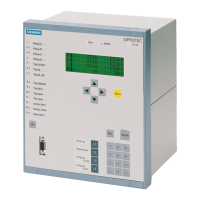2.6 Power Swing Detection (optional)
173
7SD5 Manual
C53000-G1176-C169-1
Power Swing
Blocking
The power swing blocking affects the distance protection. If the criteria for power
swing detection have been fulfilled in at least one phase, the following reactions are
possible in relation to the power swing blocking function (set in address 2002 P/S
Op. mode):
• Block all zones (All zones block): all zones of the distance protection are
blocked during a power swing.
• Blocking of the first zone only (Z1/Z1B block): the first zone (Z1) and the over-
reaching zone (Z1B) are blocked during a power swing. Faults in other zones are
tripped with the associated grading time.
• Blocking of the higher zone only (Z2 to Z5 block): the higher zones (Z2 to Z5)
are blocked during a power swing. Only the first and the overreaching zone (Z1 and
Z1B) remain active.
• Blocking of the first two zones only (Z1,Z1B,Z2 block): the first and second zone
(Z1 and Z2) and the overreaching zone (Z1B) are blocked during a power swing.
The higher zones Z3 to Z5 remain active.
Only the phases in the configured zones are blocked in which power swings were de-
tected. The associated measures taken apply to all phases when power swing has
been detected. They are active for as long as the measured impedance vector is
inside the power swing range PPOL, or if due to an abrupt change of the associated
impedance vector the power swing criteria are no longer satisfied. But the influence of
the power swing block on the distance protection relay will be prolonged for a defined
time (address 2007 Trip DELAY P/S). Thus transient states (e.g. switching opera-
tions) are compensated, which occur during a power swing and cause a jump in the
measured quantities.
It is possible with No. 4160 „>Pow. Swing BLK“ to block the power swing detection
via a binary input.
Power Swing
Tripping
If tripping in the event of an unstable power swing (out-of-step condition) is desired,
the parameter PowerSwing trip = YES is set. If the criteria for power swing detec-
tion are satisfied, the distance protection is initially blocked according to the configured
program for power swing blocking, to avoid tripping by the distance protection.
When the impedance vectors identified by the power swing detection exit the power
swing characteristic PPOL, the sign of the R components in the vectors are checked
to see if they are the same on exiting and entering the pickup polygon. If this is the
case, the power swing process is inclined to stabilize. Otherwise, the vector passed
through the power swing characteristic (loss of synchronism, case (4) in Figure 2-61).
Stable power transmission is then no longer possible. The device outputs an alarm to
that effect (No. 4163 „P.Swing unstab.“), provided that the parameter in address
2006 PowerSwing trip is set to NO. The alarm No. 4163 „P.Swing unstab.“ is
a pulse with a duration of approx. 50 ms, which can also be processed further via
output relay, e.g. for a cycle counter or a pulse counter.
Once instability is detected, the device issues a three-pole trip command, thereby iso-
lating the two system segments from each other. Power swing tripping is alarmed.
As the operating range of the power swing supplement depends on the distance pro-
tection settings, the power swing tripping
can only be active when the distance protec-
tion has been activated.
www . ElectricalPartManuals . com
